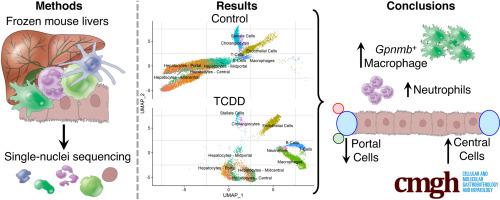Cellular and Molecular Gastroenterology and Hepatology ( IF 7.1 ) Pub Date : 2020-08-10 , DOI: 10.1016/j.jcmgh.2020.07.012 Rance Nault 1 , Kelly A Fader 1 , Sudin Bhattacharya 2 , Tim R Zacharewski 1

|
Background and Aims
Characterization of cell specific transcriptional responses to hepatotoxicants is lost in the averages of bulk RNA-sequencing (RNA-seq). Single-cell/nuclei RNA-seq technologies enable the transcriptomes of individual cell (sub)types to be assessed within the context of in vivo models.
Methods
Single-nuclei RNA-sequencing (snSeq) of frozen liver samples from male C57BL/6 mice gavaged with sesame oil vehicle or 30 μg/kg 2,3,7,8-tetrachlorodibenzo-p-dioxin (TCDD) every 4 days for 28 days was used to demonstrate the application of snSeq for the evaluation of xenobiotics.
Results
A total of 19,907 genes were detected across 16,015 nuclei from control and TCDD-treated livers. Eleven cell (sub)types reflected the expected cell diversity of the liver including distinct pericentral, midzonal, and periportal hepatocyte subpopulations. TCDD altered relative proportions of cell types and elicited cell-specific gene expression profiles. For example, macrophages increased from 0.5% to 24.7%, while neutrophils were only present in treated samples, consistent with histological evaluation. The number of differentially expressed genes (DEGs) in each cell type ranged from 122 (cholangiocytes) to 7625 (midcentral hepatocytes), and loosely correlated with the basal expression level of Ahr, the canonical mediator of TCDD and related compounds. In addition to the expected functions within each cell (sub)types, RAS signaling and related pathways were specifically enriched in nonparenchymal cells while metabolic process enrichment occurred primarily in hepatocytes. snSeq also identified the expansion of a Kupffer cell subtype highly expressing Gpnmb, as reported in a dietary NASH model.
Conclusions
We show that snSeq of frozen liver samples can be used to assess cell-specific transcriptional changes and population shifts in models of hepatotoxicity when examining freshly isolated cells is not feasible.
中文翻译:

2,3,7,8-四氯二苯并-对二恶英对肝脏影响的单核 RNA 测序评估。
背景和目标
大量 RNA 测序 (RNA-seq) 的平均值丢失了细胞对肝毒物的特异性转录反应的特征。单细胞/细胞核 RNA 测序技术能够在体内模型的背景下评估单个细胞(亚)类型的转录组。
方法
对雄性 C57BL/6 小鼠的冷冻肝脏样本进行单核 RNA 测序 (snSeq),每 4 天灌胃芝麻油载体或 30 μg/kg 2,3,7,8-四氯二苯并-对二恶英( TCDD),持续 28天用于演示 snSeq 在外源性物质评估中的应用。
结果
在对照肝脏和 TCDD 处理肝脏的 16,015 个细胞核中总共检测到 19,907 个基因。十一种细胞(亚)类型反映了肝脏的预期细胞多样性,包括不同的中央周围、中区和汇管周围肝细胞亚群。TCDD 改变了细胞类型的相对比例并引发了细胞特异性基因表达谱。例如,巨噬细胞从 0.5% 增加到 24.7%,而中性粒细胞仅存在于处理过的样本中,这与组织学评估一致。每种细胞类型中差异表达基因 (DEG) 的数量从 122 个(胆管细胞)到 7625 个(中中部肝细胞)不等,与Ahr的基础表达水平松散相关,Ahr 是 TCDD 和相关化合物的典型介质。除了每种细胞(亚)类型内的预期功能外,RAS 信号传导和相关通路在非实质细胞中特异性富集,而代谢过程富集主要发生在肝细胞中。snSeq 还鉴定了高表达 Gpnmb 的 Kupffer 细胞亚型的扩增,如饮食 NASH 模型中报道的那样。
结论
我们证明,当检查新鲜分离的细胞不可行时,冷冻肝脏样本的 snSeq 可用于评估肝毒性模型中的细胞特异性转录变化和群体变化。











































 京公网安备 11010802027423号
京公网安备 11010802027423号